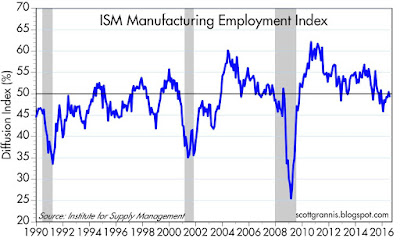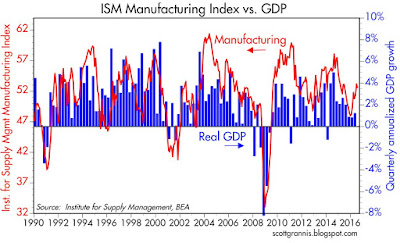This month I'm thinking along the same lines. The ADP private sector jobs number for July was +179, and for the past three months ADP has reported an average monthly gain of 178K. In order for the past three months of BLS private sector job growth to come even close to the ADP estimate for those same months is for the BLS' measure of July private sector jobs to increase by 200-225K, and that happens to be substantially more than the current market estimate of +171K. An upside surprise of that magnitude would be entirely consistent with the monthly volatile in the BLS numbers that we have seen for the past several decades, so it's not any pie-in-the-sky projection. Even if the BLS tomorrow reports a gain of 225K private sector jobs, the three-month BLS average would still be below that of ADP's. As the chart reminds us, both these series are volatile (with the BLS being far more volatile) but over time they do a good job of tracking each other.
So: if the BLS tomorrow reports as expected (+171K), then I would be forced to conclude that the labor market has weakened relative to its performance over the past several years, since the six-month annualized growth in private sector jobs would have dropped to 1.6% as compared to the 2.0 - 2.5% rates that have prevailed since early 2013. That slowdown is in fact already apparent in the ADP numbers, as you can see in the blue line in the above chart. It would take another huge upside surprise (e.g., +300K or even more) to keep the trend in jobs growth close to what it has been for the past few years.
Thus, it's likely that the economic fundamentals of the economy have weakened at least a bit so far this year, even if the BLS number tomorrow is higher than expected.
Today brought two announcements which were encouraging:
Announced corporate layoffs remain very low, and weekly unemployment claims also remain very low. To date there is no indication that businesses are starting to retrench; they are merely growing at a slower pace.
We can see signs of weakness and slower growth—but not recession—in other areas of the economy in the following charts:
The ISM employment subindex has not indicated any desire on the part of manufacturing business to expand employment for the past year.
The service sector has been slightly more willing to expand, not nearly as much as in previous years. In short, businesses are lacking the confidence to invest and expand their operations, and this is not supportive of growth. It doesn't necessarily imply a recession, but rather a "failure to thrive."
Still, the overall ISM manufacturing survey (first of the above two charts) has improved in recent months, and this suggests we are likely to see some stronger quarterly GDP growth numbers in the second half of this year—which could well be inventory-related given that inventories accounted for a good portion of last quarter's weak growth. It will still leave us mired in the slowest recovery on record, however, so it's nothing much to cheer about. Moreover, the service sector (second of the above two charts) continues to report generally healthy business activity.
The real yield on 5-yr TIPS, which I consider a good indicator of the market's GDP growth expectations, has declined by about 20 bps so far this year, and as the chart above suggests, this points to growth in the quarters and years ahead to dip below 2%. Not a recession, to be sure, but rather a modest slowdown in an already-slow-growing economy.
Construction activity had been quite strong up until the middle of last year, but has since gone flat, as seen in the chart above.
But as the June Co-Star indices of commercial real estate prices (chart above) indicates, activity in the CRE sector picked up a bit in June. This further suggests that the weakness we've seen so far this year has been more in the nature of a pause rather than a precursor of another recession.
At a more fundamental level, risk aversion (as proxied in the first of the two charts above by the demand to hoard cash and cash substitutes) continues to be a significant factor holding back the economy. (The rising blue line represents the fact that the growth of M2—arguably the best measure of spendable cash— has significantly exceeded the growth in nominal GDP for the past 8 years.) The Fed has been extremely generous with its provision of bank reserves, and banks have been lending at an above-average pace for over the past two years or so (see second chart above), but much of the extra money entering the economy has simply been socked away in the form of bank savings deposits, which in turn have been invested by banks in bank reserves held at the Fed—and which in turn represent banks' investment in Treasuries. For a more detailed discussion of this (which boils down to weak investment), see last week's post (The election should be all about growth).
I hasten to reiterate that the modest slowdown in an already-slow-growing economy apparent in the above charts is not necessarily cause for concern. An economy is not like an airplane, which runs the risk of crashing if it slows down too much. Slow economic growth can persist for many years (as it already has, of course). The worst thing about the past seven years of disappointingly slow growth is all the wealth and prosperity and jobs that have gone missing.
It's doubly disappointing, of course, because politicians, regulators, and bureaucrats have been the chief beneficiaries of our slow-growth malaise. More power to the public sector necessarily follows from less freedom for the private sector.

















6 comments:
Great blogging.
Long and variable lags...is the economy now paying the price for Fed tightening earlier this year?
And with slow growth and the Fed below its stated inflation target, why is the Fed tightening?
I think the I think the aircraft at stall speed analogy actually holds some water, to mix my metaphors.
Might be time to consider money financed fiscal programs, also called helicopter drops.
Right on the money! That is why I read your blog when possible. Thank you Scott.
Wow, big number. Way above consensus. Fed will def move in Sept and bonds may finally trade higher in yield. Not sure that the market will like it but given that Trump has cratered and that a strong labor market bolsters incumbent party we could see a landslide victory for Hillary which would be disaster for GOP hopes of retaining congress.
Scott, great charts and congrats on basically nailing the jobs number. But a question of clarification: I didn't get the title of the blog. Why do you think a better-than-expected jobs report would be disappointing? I re-read the piece and still don't get it. Is it b/c you think the Fed is more apt to tighten?
It's disappointing because it wasn't big enough to fully reverse the extremely weak growth of jobs last May. The growth rate of private sector jobs is slowing.
Thanks for this world class blog post. The information shared here is just fantastic. Without a doubt, one of the best blog posts that I've studied in recent years. Extremely pleased with this! write customer service resume
Post a Comment